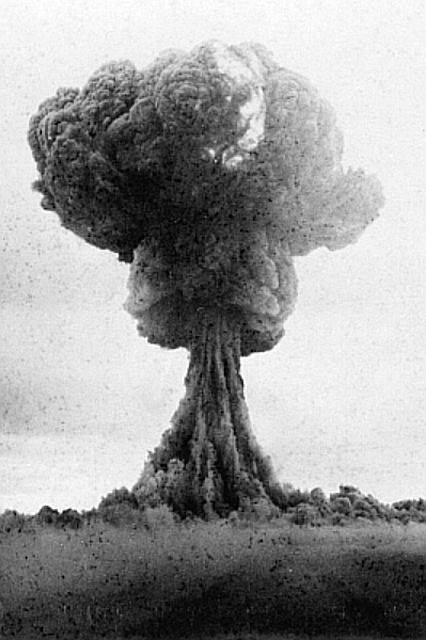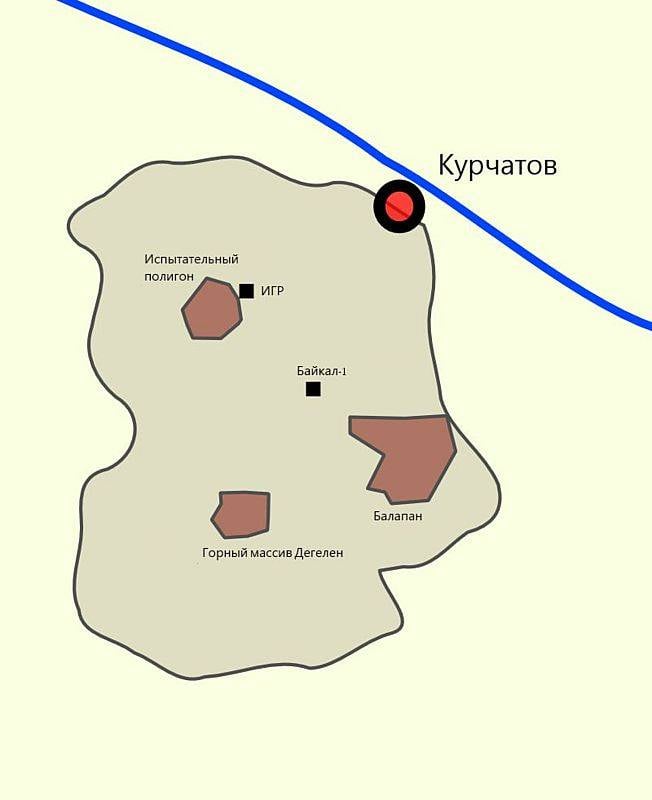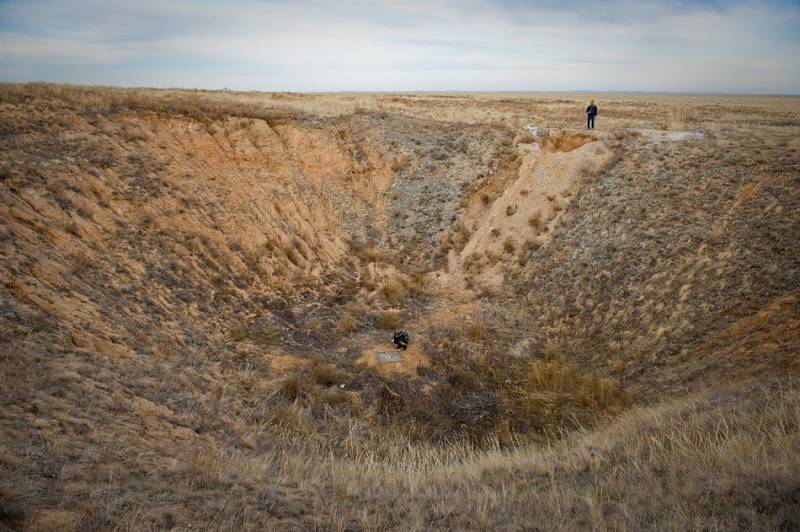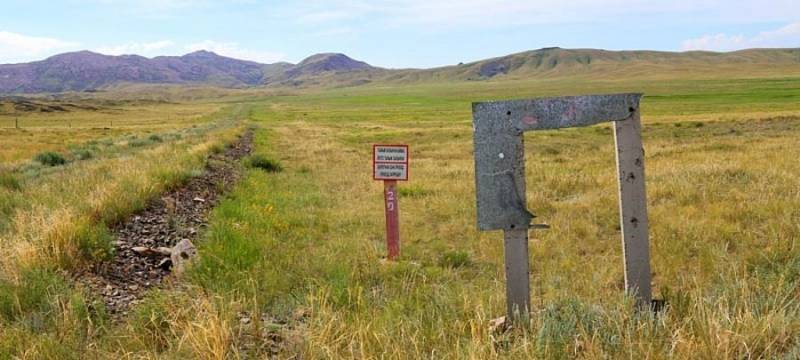First Soviet underground nuclear tests
The general public learned about the existence of the Semipalatinsk nuclear test site only after the Soviet Union ceased to exist. Currently, the landfill is located on the territory of independent Kazakhstan, 130 kilometers north-west of the city of the same name, on the left bank of the Irtysh River. The formerly closed city of Kurchatov, named after the famous Soviet physicist Igor Kurchatov, is located on the territory of the test site.
The Semipalatinsk nuclear test site was actively exploited from 1949 to 1989; for the entire time, at least 456 underground and 122 atmospheric nuclear tests were carried out here. Different sources provide different information on the number of tests performed.
So, for example, there is information that nuclear tests weapons and explosions for peaceful purposes at the test site were carried out 715. And the total number of detonated nuclear charges was 969 units. Most of these explosions were carried out as part of a large-scale program to achieve nuclear parity with the United States.
The landfill is notorious today for the reason that seriously polluted areas of the area remain on an area of 18 square kilometers. At the same time, for many years after the collapse of the USSR, the territory was not protected in any way, and the population used it for grazing livestock. Separately, it should be noted that the Semipalatinsk nuclear test site is the only one in the world where the population lives.
What preceded the first underground nuclear tests
The construction of the Semipalatinsk nuclear test site began in 1947, and in August 1949 the first nuclear explosion took place here. The first nuclear weapon test in the USSR was carried out here. On August 29, 1949, the first Soviet nuclear bomb RDS-1 with a capacity of 22 kilotons exploded at the test site.

The explosion of the first Soviet nuclear bomb RDS-1, photo: wikimedia.org
As subsequent experience showed, the test site, created as part of a large-scale Soviet atomic project, was located extremely well. The terrain within the boundaries of the test site allowed the military to carry out underground nuclear explosions both in adits and in wells. The first underground nuclear tests at the Semipalatinsk test site took place 60 years ago - on October 11, 1961.
At the same time, the palm in such explosions belonged to the American military. On November 19, 1951, tests were carried out in the USA at the Nevada proving ground under the code designation "Uncle". The nuclear explosion was carried out at a shallow depth - only 5,5 meters. The power of the detonated charge was 1,2 kilotons. The purpose of the tests, the US military designated the verification of the damaging factors in this type of explosions.
An underground nuclear explosion, which was carried out six years later, on September 19, 1957, can be considered truly complete. At the same training ground in Nevada, the US military conducted tests of the "Rainier". This time, a 1,7 kiloton nuclear charge was detonated in a tunnel in a rock at a depth of 275 meters.
These nuclear tests were carried out to refine the methodology for conducting underground nuclear explosions. In addition, the Americans have tested in practice the capabilities and methods of early detection of explosions of this kind. By laying the foundations for underground nuclear testing, the Americans made it possible for them to be carried out in the future.
After the signing of the Moscow Treaty of 1963, which banned nuclear tests in the atmosphere, under water and in outer space, underground nuclear tests remained the only option available in the arsenal of the military of the two countries. The Soviet Union, which at the beginning of the nuclear race acted as a catch-up, conducted its first underground nuclear tests later than the Americans.
Preparing an underground nuclear explosion
The Soviet military, like their American counterparts, set themselves the same goals when conducting the first underground nuclear tests. First of all, they were interested in methods and means of early detection of ongoing underground nuclear explosions. At the same time, preparations for the first underground nuclear tests began several years before they were carried out.

Approximate scheme of the Semipalatinsk nuclear test site, photo: wikimedia.org
Preparatory work for the first Soviet underground nuclear explosion began in 1958. An adit was specially prepared for testing, which was laid in a rock mass on the territory of the Semipalatinsk test site. The adit, named B-1, was made in the low-mountain Degelen massif.
The total length of the adit was 380 meters, and the explosion itself was carried out at a depth of 125 meters. After the construction of the adit was completed, a container with a nuclear charge located inside with a total capacity of about 1 kiloton was brought into the explosion chamber on a special trolley.
In order to prevent the release of radioactive dust to the surface of the earth, the adit was sealed. For these purposes, specialists have organized three "driving areas". The first section was 40 meters long. This section consisted of crushed stone backfill, as well as a reinforced concrete wall. In the first plug there was a pipe that was used to output the flux of neutrons and gamma radiation after a nuclear explosion to the sensors of the instruments, which were supposed to track the entire process of nuclear tests.
The second driving section, 30 meters long, consisted of numerous reinforced concrete wedges. The third section, 10 meters long, was located at a distance of 200 meters from the nuclear explosion chamber. At this site, three instrument boxes were installed, in which numerous measuring equipment was placed. At the same time, the specialists placed measuring instruments along the entire length of the adit.
The epicenter of the future explosion was located on the surface of the mountain directly above the nuclear explosion chamber, arranged in the rock. For clarity, a red flag was placed at the top. Additionally, scientists placed experimental animals at the site of the explosion.
Nuclear test No. 117
The tests, designated Nuclear Tests No. 117, were scheduled for October 11, 1961. On the specified day, a radio signal was sent from the control panel, which was located at a distance of five kilometers from the completed adit. In the area of the command post, sophisticated equipment was also installed, necessary for observing and registering the seismic and electromagnetic waves of the explosion.

Semipalatinsk test site. Land subsidence as a result of an underground nuclear explosion, photo: voxpopuli.kz
The radio signal activated many scientific instruments and measuring equipment, and also launched the detonation of the nuclear device itself. The explosion turned out to be powerful enough to raise the entire mountain massif above the epicenter to a height of 4 meters. During the explosion, an immediate serious destruction of the surface rocks occurred, which contributed to the appearance of a dense cloud of dust and small particles of soil and rock, at the same time a rockfall was recorded.
The positive moment of the tests was that no radioactive products were thrown onto the surface, and the fireball characteristic of a nuclear explosion was not observed. The adit created by Soviet engineers kept the power of a nuclear explosion underground.
According to the recollections of eyewitnesses of the tests, at the time of the explosion, the mountain rose several meters, but then quickly settled into place. At the same time, even at a considerable distance from the epicenter of the explosion, a strong vibration of the earth's surface was clearly felt. After the dust from the explosion had settled, scientists and workers went to the adit. They quickly established that the section of the adit before the third drive was in good condition. The boxes with scientific equipment installed here remained intact.
The dosimetrists working in the adit determined that there was no radioactive contamination of the area in the area of the third drive. At the same time, scientists were able to get directly to the epicenter of the first Soviet underground nuclear explosion only in 1964. In order to get into the explosion chamber littered with the collapsed rock, it was necessary to organize the conduct of mine workings.
The tests carried out in October 1961 were considered successful. At the same time, they opened up the possibility of further conducting underground nuclear explosions. After the signing in 1963 of a trilateral agreement between the United States, the USSR and Great Britain banning nuclear tests in the atmosphere, under water and in space, underground nuclear explosions remained the only available military method for testing new types of nuclear weapons.

Information